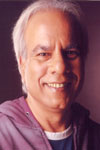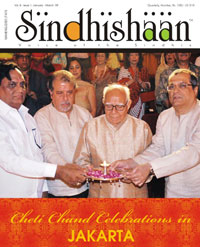THE COLUMN
1948 – 2008 On a Walking Stick made of Gold!
60 years of Sindhyat
By Arun Babani

In my Sindhi medium school in the mid-sixties there were two boys, Gul and Kishore. They were close friends with one thing in common – they had both learnt a few words of English and tried to converse with each other in that language. Once, I happened to ask Gul about this and he explained that he lived at Warden Road where all his neighbourhood friends spoke only in English which made him feel miserable. So somehow the urge to learn English and feel confident was overpowering. These guys, Gul and Kishore, I later realized, were the harbingers of the massive revolution that took over India in general and Sindhis in particular, the revolution of convent education.
Even in those early days the Sindhi schools were less than proper. For one, most schools were in distant areas. We traveled one hour every morning from Worli to Grant Road! Also the facilities were poor compared to the convent schools which had large playgrounds, auditoriums, laboratories . . . . And in comparison we looked like poor country cousins . . . . ! Our schools mostly survived on charity and donations. So it is no surprise that our Sindhi schools just withered away within the larger changing social scenario that India was going through in the 60s and 70s. With the closing of Sindhi schools, Sindhi culture suffered the first serious blow.
-----------------------------------------
The Sindhi Cultural Scene too met with the same fate during the last 60 years. In the early beginnings during the 50's and 60's, there was a tremendously rich cultural fare. There were the yearly sammelans attended in thousands by the Sindhi populace; there were the Drama Festivals, in different cities and towns of India; there were the all night Bhagat Festivals, where for days together there were festivities, brotherhood, optimism and dreams. Almost every other week new plays were performed, new singers were born and the Sindhi life was promising and beautiful.
Slowly during the mid-seventies the change began to be felt. During these times, the call for Sindhi youth began to be first heard loud and clear. The original energy and enthusiasm began to wane, giving way to lethargy and hopelessness. By the 90s the rules changed completely. Those literary and cultural Sindhi Sammelans were slowly being replaced by International meets, attended mostly by the wealthy Sindhi businessmen instead of artists and writers, with focus on food, fashion and festivities rather than on culture and creativity.
Well, things change, times change, people change. The rich Sindhi culture of our forefathers took a solid beating and in its place, some cut-paste Sindhi culture appeared in the name of new Sindhi fashion. Slapstic comedies, filmi songs and dance, Sindhi 'Rap' began to call itself the new face of young Sindhis. The older Sindhi did not accept this hotch-potch while the younger Sindhis were ignorant of our traditions. A conflict, a crisis began to be felt around mid-eighties and nineties regarding the direction the Sindhi society was beginning to take.
-----------------------------------------
With Alaf, ba, pa being quickly replaced by A, B, C and with local sammelans being pushed aside by the new international gloss, it was no surprise that the Sindhi language, the mother tongue suffered the exclusion from daily lives and homes of Sindhis. Sindhi literature was the first to feel the heat followed by Sindhi newspapers and magazines which turned to English for survival, because they simply could not sustain with the shrinking Sindhi readership. Spoken Sindhi too followed suit, attacked by a mistaken sense of shame and lack of pride. All these factors together marked the severest blow inflicted on a community : the loss of Sindhi identity.
Countless seminars have so far discussed and dissected the concept of separate, distinct Sindhi identity. What is it? Where has it disappeared? The Sindhi identity began to be felt unsuitable by young Sindhis eager to vote for modernity and progress. And so the Sindhi youth, by and large, began to discard it, by first changing their names and surnames, then by dressing up differently and so on. They felt that the burden of Sindhiat was cramping their style and their dream of global citizenship. For a Sindhi, the choice was clear : either be a Sindhi or be global and modern. Gul and Kishore of my school took that jump in the early sixties itself; later to setup a Jetsetting travel business.
But the question of Sindhi identity in today's changing world doesn't disappear. The issue is to marry modernity with tradition, join roots with new directions. An executive at the Taj Banquets tells me, 'When Sindhis organize a wedding, they'll have every other cuisine except 'Sindhi' food, this inspite of our persuasions.'
-----------------------------------------
Sindhi forums have been discussing for a long time the phenomenon of the lost Sindhi pride among its young community members. What to do about this dangerous trend that has been around and growing since a long time? How to revive the lost confidence about their ancestors, rich heritage? No new answer has been heard apart from empty words of advice and more advice. All this doesn't seem to make a difference to the young Sindhi who doesn't feel proud and confident about Sindhiat. That seems to be the case, more or less, of an entire Indian youth vis-à-vis western society. A survey conducted by the 'Outlook' magazine showed the inferiority an average Indian youth feels when compared to their American or European counterparts. So this lack of pride is not only a Sindhi affliction; it is Pan-Indian. Moreover even the previous generation of Indians, right from the British times felt the same lack. So the Sindhi lack must be placed in proper perspective of global measurements.
-----------------------------------------
In the last sixty years our community has lost much, as we can see from previous pages. One more important loss is that of Sindhi festivals. During the 80's, the Khalistan movement came into being and suddenly from that time onwards, Guru Nanak Birthday Celebrations became a thing of the past. Before that, the yearly Gurupurbh was very very popular, a big uniting factor for the Sindhi community. Every year on that full moon night Sindhis came out on the streets in thousands to celebrate their Guru's birthday which fell at 1.20 a.m. and there were all night merriment and festivity on the roads of Mumbai and other Indian cities. There used to be hundreds of Tikanas, Darbars which organized the three day celebrations on a massive scale, with free lunch and dinner on all the days, known as 'Langar'. There were music groups, bhajan mandals, kirtan tolis that entertained the masses.
Suddenly around the 80's the whole thing came under the shadow of fear. The functions were subdued, kept indoors and the energy disappeared from the holy event.
Two more popular Sindhi festivals of Thadri and Teejri too have disappeared at least from the big cities. Thadri was enthusiastically observed throughout Sindhi community, with eating of stale food and all night gambling. A togetherness which resulted in much merriment and festivity. Teejri, mostly a ladies festival, also has run out of steam and is no longer heard of or even observed.
-----------------------------------------
To be fair, on the positive side, apart from losing language, culture and youth to the winds of change, Sindhis have managed to excel in business with countless flourishing business ventures to the community's credit. To begin with, Sindhis always were and are known and respected for their business acumen or sense of pride at creating fortunes. And so, in the last sixty years there are many success stories amidst Sindhis, where a lone Sindhi youth has sailed to distant shores and in barely 2 or 3 decades has moved mountains and been victorious over difficult if not impossible destiny. And now, in the beginning of this century, many of these winners come back, searching for lost addresses, forgotten roots and familiar trees, which begins to explain the significance to them of these international meets where these very successful middle aged tycoons seek their brothers, their lost contacts and Sindhi grooms for their lovely convent educated rich daughters! Well, times change, things change, people change.
-----------------------------------------
So, has the dream come true then? Lets look at the balance sheet.
At the time of partition many Sindhi families kept the keys to their ancestral homes with neighbours telling them they'll return in few weeks. That dream of returning to the motherland soon vanished into the thin air. Then, faced with new, harsh realities, the Sindhis began to dream of holding themselves together, facing the crisis and building themselves – not huts, not cottages or flats, but palaces. That dream has already seen the light of the day. Then there was a dream to create another Sindh in Hind. Although the effort and energy was put in by the founding fathers of the community, that dream of a separate Sindhi state was not realized. And lastly there was the dream of keeping Sindhi language, culture and tradition alive. This was the costliest of all dreams and the Sindhis as a community could not put in enough investments to realize this very valuable dream. In the first 20 or 30 years, much investment in terms of vision, energy, effort and time was put in but then the bigger socio-cultural-economic factors spelling forces of change began to blow and the Sindhis, sadly, could not save their soul, even within the expensive villas they had created all around the globe!
-----------------------------------------
An old Sindhi proverb says, 'Sathh ta khan lath!' (At sixty one carries a walking stick). At sixty now, the Sindhi culture is carrying a walking stick because it is weak, infirm and shaky. But the good news is that the walking stick is made of Gold . . . . studded with pearls and diamonds . . . yet, it is nothing more than a walking stick. . . . . . .


